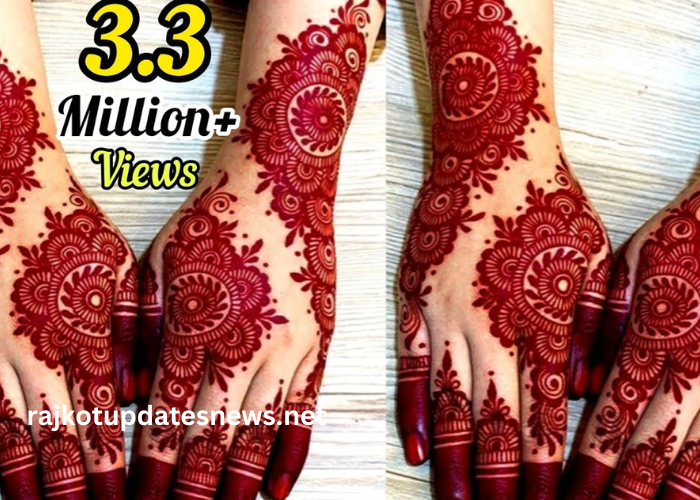Mehndi design, often referred to as henna art, has deep-rooted significance in various cultures, particularly in South Asia, the Middle East, and North Africa. This intricate art form involves applying a paste made from the leaves of the henna plant, resulting in beautiful patterns that adorn the skin, primarily the hands and feet.
The significance of mehndi goes beyond mere decoration; it symbolizes joy, celebration, and cultural identity. In contemporary times, the popularity of mehndi design has surged, with innovative styles emerging to cater to modern aesthetics while preserving traditional elements.
Key Points
- Mehndi designs are a blend of tradition and modern aesthetics.
- The application of mehndi holds cultural significance in various ceremonies.
- Contemporary designs showcase creativity and innovation in artistry.
What Is Mehndi Design?
Mehndi design refers to the artistic patterns created using henna paste on the skin. Traditionally, mehndi is applied during auspicious occasions like weddings, festivals, and religious ceremonies.
The art form has evolved over time, with intricate patterns ranging from floral motifs to geometric designs. While traditionally practiced, modern styles have introduced innovative techniques, making mehndi a popular choice for fashion statements at parties and events.
How Is Mehndi Applied?
The application of mehndi involves several steps that require skill and creativity. First, the henna leaves are dried and ground into a fine powder, mixed with water to create a paste. The paste is then filled into a cone for precise application.
An artist carefully applies the designs onto the skin, allowing it to dry before removing it. The intensity of the color depends on the duration the paste remains on the skin and the individual’s skin chemistry.
What Are the Different Styles of Mehndi Design?
Mehndi designs can be classified into various styles, each reflecting different cultural backgrounds and preferences. Some popular styles include:
- Indian Mehndi: Known for its intricate and detailed patterns, Indian mehndi often features motifs like peacocks, flowers, and paisley designs.
- Arabic Mehndi: This style is characterized by bold, flowing lines and floral patterns, often with a less intricate approach compared to Indian designs.
- Moroccan Mehndi: Featuring geometric patterns and repetitive motifs, Moroccan mehndi designs are distinct in their angular style.
- Pakistani Mehndi: Pakistani designs often incorporate fine lines and elaborate patterns, showcasing a blend of Indian and Arabic influences.
- Modern Mehndi: This style embraces contemporary trends, incorporating unique elements like glitter, beads, and intricate stencils.
What Is the Cultural Significance of Mehndi?
Mehndi holds a significant place in various cultures, particularly in South Asia. In Indian culture, it is an essential part of wedding celebrations, where brides often have elaborate designs applied to their hands and feet as part of their adornment.
The darker the henna stain, the more love and affection the bride is believed to receive from her in-laws. In Middle Eastern cultures, mehndi is used during festivals and special occasions, symbolizing joy and celebration.
How Do Mehndi Designs Vary for Different Occasions?
The design of mehndi can vary significantly depending on the occasion. For weddings, brides often opt for intricate designs that cover the entire hand and forearm. In contrast, for festivals like Eid, lighter and simpler designs may be preferred.
The designs can also be personalized based on individual preferences, with some choosing to include meaningful symbols or initials.
Are There Specific Patterns Associated With Mehndi?
Certain patterns are commonly associated with mehndi designs, reflecting cultural symbolism. For instance, peacocks symbolize beauty and grace, while lotus flowers signify purity and enlightenment.
Other motifs like mandalas and geometric patterns have gained popularity due to their aesthetic appeal and intricate detailing.
What Are the Latest Trends in Mehndi Design?
As with any art form, mehndi design continuously evolves. Recent trends include minimalist designs, which focus on clean lines and negative space, contrasting with the traditionally elaborate styles.
Additionally, the use of colors in mehndi has gained traction, with artists incorporating various hues to create vibrant designs.
How to Choose the Right Mehndi Artist?
Selecting the right mehndi artist is crucial for achieving the desired design. Look for artists with a strong portfolio showcasing their previous work. Recommendations from friends or family can also guide you toward skilled professionals.
Additionally, discussing your preferences and expectations with the artist before the application can lead to a more satisfying experience.
What Are the Health Considerations for Mehndi?
While henna is generally safe, some individuals may experience allergic reactions to certain additives used in commercial mehndi products. It’s advisable to conduct a patch test before applying henna extensively. Pure henna should ideally be free from harmful chemicals, ensuring a safe and enjoyable experience.
How to Care for Mehndi After Application?
Post-application care is vital for ensuring the longevity and vibrancy of mehndi designs. It is recommended to keep the design dry for the first few hours, allowing the dye to set into the skin. Afterward, applying natural oils can help enhance the color. Avoiding soap and water on the design for the first 24 hours can also prolong its life.
What Are the Common Myths About Mehndi?
Several myths surrounding mehndi can lead to misconceptions. One common myth is that mehndi is solely for women. While traditionally more popular among women, men in many cultures have also embraced the art form, especially during festive occasions. Another myth is that henna is harmful; however, when used correctly, natural henna is safe and non-toxic.
How to Create DIY Mehndi Designs at Home?
Creating your own mehndi designs at home can be a fun and fulfilling activity. Begin by practicing simple patterns on paper before applying them to your skin. Various online resources offer tutorials and step-by-step guides to help you master the art of mehndi. Additionally, you can purchase natural henna kits to ensure safety and quality.
What Are Some Popular Mehndi Design Ideas?
Some popular mehndi design ideas include:
- Floral Patterns: Incorporating flowers, vines, and leaves for a natural look.
- Geometric Shapes: Using lines and shapes for a modern twist.
- Bridal Mehndi: Elaborate designs featuring intricate detailing for brides.
- Minimalist Designs: Simple yet elegant designs focusing on negative space.
- Cultural Motifs: Incorporating symbols that hold personal significance.
How Do Mehndi Designs Influence Fashion Trends?
The influence of mehndi designs extends beyond cultural significance, impacting fashion trends as well. Many fashion designers draw inspiration from traditional patterns, incorporating them into clothing, accessories, and even tattoos. The fusion of mehndi artistry with fashion showcases a blend of tradition and modernity.
Comparison of Mehndi Design Styles
| Style | Characteristics | Popular Occasions |
| Indian Mehndi | Intricate, detailed patterns | Weddings, festivals |
| Arabic Mehndi | Bold, flowing lines | Weddings, celebrations |
| Moroccan Mehndi | Geometric patterns | Cultural events |
| Pakistani Mehndi | Elaborate and fine details | Weddings, religious ceremonies |
| Modern Mehndi | Minimalist, colorful designs | Fashion events, parties |
What Are Some Famous Mehndi Artists to Follow?
Several renowned mehndi artists have gained recognition for their exceptional skills and creativity. Artists like Minal’s Mehndi, Henna by Hannah, and Jasmin’s Henna Designs have garnered a significant following on social media platforms, sharing their unique styles and techniques.
How to Promote Your Mehndi Business?
For aspiring mehndi artists looking to establish their business, effective promotion is key. Utilizing social media platforms like Instagram and Pinterest can help showcase your designs to a broader audience. Additionally, collaborating with event planners and participating in local fairs can provide exposure and attract potential clients.
Conclusion
Mehndi design, with its rich cultural heritage and evolving styles, remains an essential art form that continues to captivate hearts. Whether it’s a wedding, festival, or a casual gathering, mehndi adds a touch of elegance and celebration to any occasion.
By understanding its significance, exploring various styles, and appreciating the artistry involved, one can truly embrace the beauty of style:40egud3wji4= stylish:5gyltkpyaby= Mehndi Design.
FAQ’s
- What is the difference between traditional and modern mehndi designs?
Traditional mehndi designs are often intricate and culturally specific, while modern designs may incorporate minimalistic and colorful elements. - How long does mehndi last on the skin?
Mehndi can last anywhere from 1 to 3 weeks, depending on skin type, aftercare, and the quality of henna used. - Can mehndi be applied on all skin types?
Most people can safely apply mehndi; however, those with sensitive skin should conduct a patch test to check for allergies. - What is the best way to remove mehndi?
Mehndi fades naturally over time, but if you wish to remove it faster, exfoliating the skin with scrubs or oils can help. - Are there any side effects of applying mehndi?
When used properly, natural henna is safe; however, reactions can occur with chemical additives found in some commercial products. Always choose natural henna for best results.



